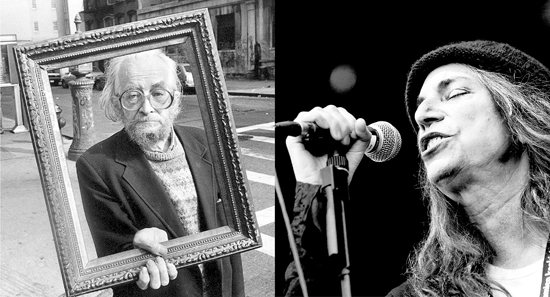An experimental filmmaker, ethnomusicologist, artist and avid collector of Ukrainian Easter eggs, Harry Smith was a 20th century American Renaissance man. Tonight, Patti Smith and friends will celebrate this eccentric bohemian’s life, as well as the release of the book “Harry Smith: The Avant-Garde in the American Vernacular” with the “Smith on Smith” event at the UCLA Hammer Museum.
“I’m glad to say my dreams came true. I saw America changed by music,” Harry Smith once said upon receiving a 1991 Grammy Award for his contribution to American folk music.
Smith had something to do with that change, with the release of his collection of recordings called “Anthology of American Folk Music.” It is often credited as triggering the 1960s urban folk revival that happened in college towns across the country and influenced everyone from Bob Dylan to Wilco.
Patti Smith, who is not related to him, was also influenced by him ““ the two met at New York’s Chelsea Hotel in the 1970s and became very close. Their reciprocal inspiration made Patti Smith an ideal choice to front the event, and Claudia Bestor, director of public programs and education at the Hammer Museum, wanted to invite performers who were friends of Harry Smith.
Influencing many, Harry Smith was also influenced by sources such as Plato’s “The Republic.” Like Plato, Smith believed that societies have rhythm, and if you change the music of society, you change the very nature of the society, just as the songs he recorded helped create the 1960s counterculture.
“He certainly changed the entire definition of what folk music was in this country,” said Andrew Perchuk, co-editor of the book “Harry Smith.” “He found darker, odder folk music that was barely known.”
Smith was exposed to this music at an early age.
Growing up in the Pacific Northwest during the Great Depression, he was close to many Native American tribes and recorded their songs and rituals.
He also collected cheap regional American folk music during World War II, a time when records were being melted down for their shellac to make weapons.
“He leapt with both feet into every area he had questions about. He made his art for experimentation and curiosity,” Bestor said.
After rescuing traditional treasures from the trash, Harry Smith moved to the San Francisco Bay Area, where the atmosphere was rich with bohemia and jazz.
That was where he first got involved with experimental films at the San Francisco Museum of Modern Art. He lived above Jimbo’s Bop City, an after-hours jazz club, whose walls had murals he painted. Living off of friends’ and buyers’ support, he led a precarious existence.
“He had a broad range of artistic activities. One of the reasons he’s not better known is because he didn’t concentrate on just one thing,” Perchuk said. “He was interested in basic structures of thinking that go between certain art forms, so he didn’t restrict himself to just one.”
An ardent explorer and innovator, Harry Smith found new ways of expression through pre-existing mediums. He transcribed jazz tunes onto his paintings that musicians could read and play, as well as helped pioneer the technique of painting directly onto filmstrips instead of shooting films with a camera.
He would show the films with different kinds of music or colored gels, exploring the connections between image and sound, as well as those across cultures.
“He had the vision to pull all these disparate things together and create something that was so unique and new, it was like two plus two makes six,” said Rani Singh, co-editor of the Harry Smith book. “Harry Smith was searching for patterns across different disciplines and media to make sense of the world and man’s place in it, to find similarities in cultures and traditions that connected across cultural lines.”
Like Smith’s work, the new book co-edited by Singh and Perchuk pieces together disparate parts into a coherent whole.
“It was the first attempt to try and bring his career together, so it could be assessed as a whole,” Perchuk said. “In addition to having great images, the book also has rare reprinted documents, which give a really interesting portrait of the man himself, as well as the different writers commenting on his art.”
Singh had many interesting conversations with Smith as an assistant to him late in his life. These discussions exposed many of his eccentric qualities.
“Spending time with Harry was a unique experience ““ you never knew what kind of person would show up in his room or what books and collections and things he would have out. A conversation with him would go from a 1926 ethnographic review to the latest issue of a nature magazine. It was really a whirlwind of ideas. He was a wry, witty, bizarre person who had a singular mind,” Singh said.
The event will emphasize these qualities and include reading some of his work, showing film clips and playing recordings he made.
Bestor suggests getting in line early for the event, which is expected to attract hundreds of people. An active audience helps keep Smith’s work alive long after his passing.
“It’s really important to me that these materials remain fresh and vibrant and alive, not dusty file folders in a museum drawer,” Singh said. “The Smith on Smith event is a perfect way to focus on Harry’s work, legacy and connection to important artists, performers and thinkers of our time. It’s a great opportunity to trace back through to those moments when artists were more focused on the act of creation and survival, the next meal and the next day. When existence was art and art was existence.”
